Home / Pink Floyd Timeline / Finding Their Feet 1968
The previous chapter in Pink Floyd’s History took us through Syd Barrett’s Pink Floyd. Syd left the band in April 1968 with David Gilmour replacing him. There would be a period where the band had to come to terms with loosing their main song writer and front man.
The year 1968 marked a significant transitional period for Pink Floyd, characterized by both the departure of Syd Barrett and the arrival of David Gilmour. As the year began, Barrett’s mental health was visibly deteriorating, impacting his performance and contribution to the band. His behaviour was increasingly unpredictable, often affecting his ability to perform live. This instability within the group led to a critical decision: the addition of David Gilmour, a talented guitarist and an old school friend of Barrett’s, in January 1968. Initially, Gilmour was brought in as a temporary solution to cover for Barrett’s erratic performances, but his role quickly became permanent.

The shift in the band’s lineup also led to a change in its creative direction. With Barrett’s departure in April, the responsibilities of songwriting and leadership gradually shifted towards Roger Waters and Richard Wright. This transition marked the beginning of a new era for Pink Floyd, moving away from Barrett’s psychedelic influence towards a more thematic and progressive rock style.
One of the most significant milestones of 1968 for Pink Floyd was the release of their second album, “A Saucerful of Secrets,” in June. This album was pivotal as it was the first to feature Gilmour and the last to include contributions from Barrett. It showcased the band’s evolving sound, moving towards more experimental and spacey compositions.

Despite these internal changes, Pink Floyd continued to enhance their reputation with captivating live performances, known for their innovative use of visuals and immersive sound experiences. Meanwhile, Syd Barrett, after leaving the band, started working on his solo career. His first solo album, “The Madcap Laughs,” would eventually be released in 1970.
Overall, 1968 was a watershed year for Pink Floyd, marking the end of the Barrett-led psychedelic phase and setting the foundation for the band’s future success with albums like “The Dark Side of the Moon” and “Wish You Were Here.”
Pink Floyd Timeline : 1968,
Timeline: 1968
1 February 1968

Recording Saucerful of Secrets at Abbey Road Studios
Pink Floyd had a studio session day on 1st February 1968 working on their second album Saucerful of Secrets.
The creation of Pink Floyd’s second album, “A Saucerful of Secrets,” at Abbey Road Studios marks a significant period in the band’s history, particularly due to the transition of band members. The album’s production saw a critical shift from Syd Barrett, a founding member and primary songwriter, to David Gilmour, who would become a key figure in the band.
Transition from Syd Barrett to David Gilmour: Barrett’s mental health issues and erratic behavior had increasingly impacted the band. His contribution to the album was limited due to these issues. David Gilmour, who joined the band in December 1967, gradually took over Barrett’s role, both as a guitarist and as a significant creative force.
Recording at Abbey Road Studios: The Abbey Road sessions for “A Saucerful of Secrets” were a time of experimentation and adaptation for Pink Floyd. The band worked on integrating Gilmour’s style with their existing sound. This period was crucial in shaping the direction Pink Floyd would take in their subsequent works.
Musical Style and Themes: The album itself marked a departure from the singular vision of Barrett and moved towards a more collaborative and experimental sound. The tracks on “A Saucerful of Secrets” showcased a blend of psychedelic rock and emerging progressive rock elements, hinting at the more elaborate compositions that Pink Floyd would later become famous for.
Legacy of ‘A Saucerful of Secrets’: Although not as commercially successful as some of their later albums, “A Saucerful of Secrets” is considered a pivotal moment in Pink Floyd’s evolution. It represents a bridge between the early psychedelic sound led by Barrett and the more complex, thematic music that would define their later work.
This album is a testament to Pink Floyd’s ability to adapt and evolve amidst significant internal changes, setting the stage for their future success and innovation in the world of rock music.
Note: Picture from an earlier session in 1968
17 February 1968

The beginning of a five-date tour in the Netherlands and Belgium, showcasing new material and expanding their European presence.
Picture: 968 Pink Floyd Bouton Rouge, ORTF Studios, Buttes Chaumont, Paris., 20 February 1968. Live performances of Astronomy Domine, Flaming, Set the Controls for the Heart of the Sun, and Let There Be More Light. Read more about Pink Floyd World Tour 1968.
March 1968
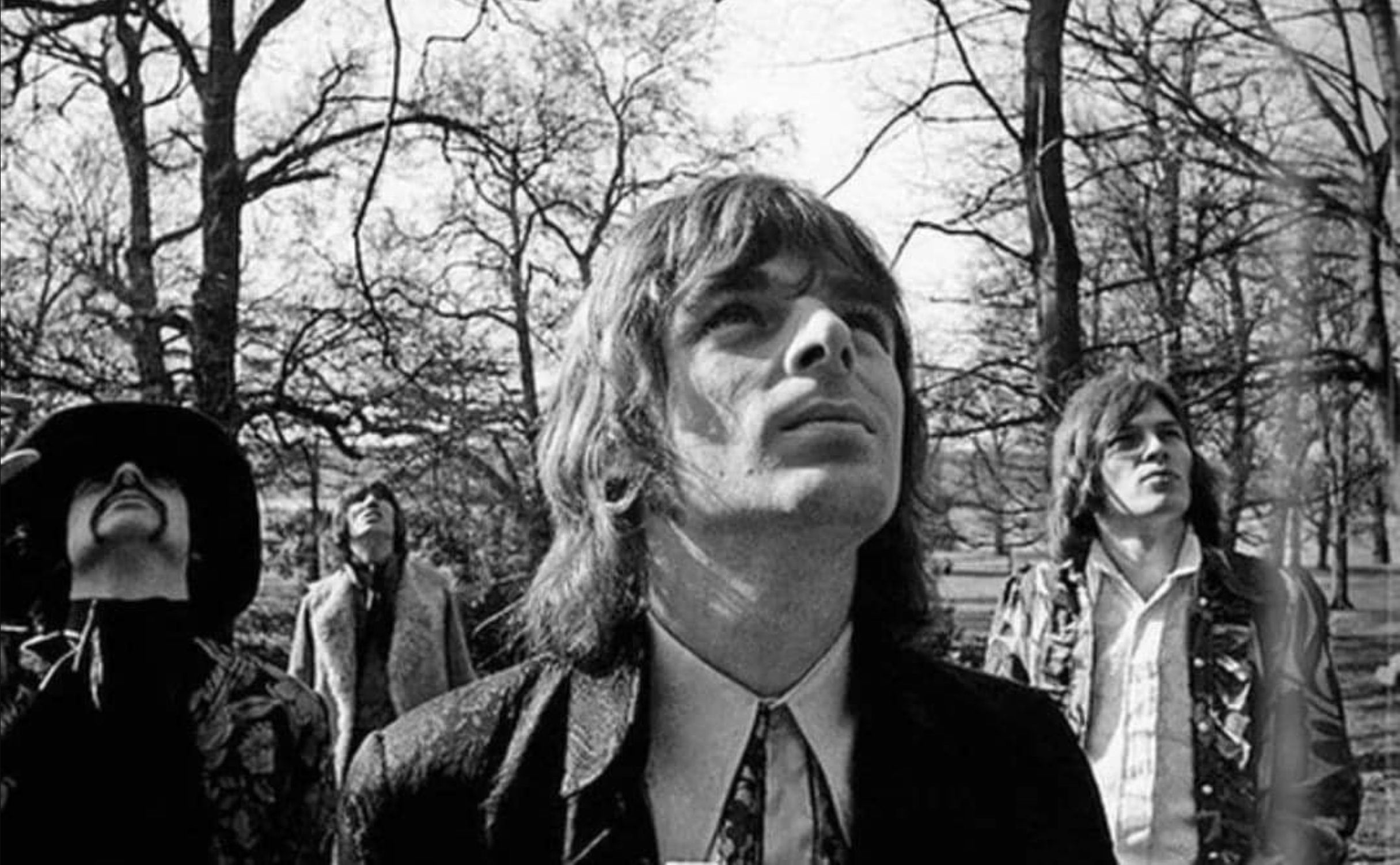
Pink Floyd Hampstead Heath Photoshoot 1968
Pink Floyd did a photo session for the Saucerful of Secrets album promo that would be released in June 1968. They were possibly recording Arnold Layne (Alternative version) at Hampstead Heath and St. Michael’s Church, Highgate, London, UK
1 March 1968

Dissolution of Pink Floyd’s partnership with Blackhill Enterprises and the acquisition of new manager Steve O’Rourke
Pink Floyd’s manager from 1968 to 2003 when he passed away. At his funeral, David Gilmour performed Fat Old Sun, and then Great Gig In The Sky, joined by Nick Mason and Richard Wright. A keen racing driver, he set up EMKA Racing in 1980 named after EMKA Productions, his management company.
16 March 1968

Syd Barrett Turns Up at Middle Earth Gig
With UFO club having closed down due to police pressure and John Hoppy Hopkins being sent to prison, Middle Earth in Covent Garden was the hip place to be. Syd Barrett turned up to the gig and stood in the audience staring at David Gilmour who had replaced him in the band.
David Gilmour told Zigzag magazine, “I remember on terrible night when Syd [Barrett] came and stood in front of the stage. He stared at me all night long. Horrible!”
This moment is often remembered as emblematic of the strange and strained relationship between Barrett and the band following his departure. It’s also reflective of Barrett’s unpredictable behaviour during that period of his life.
28 March 1968
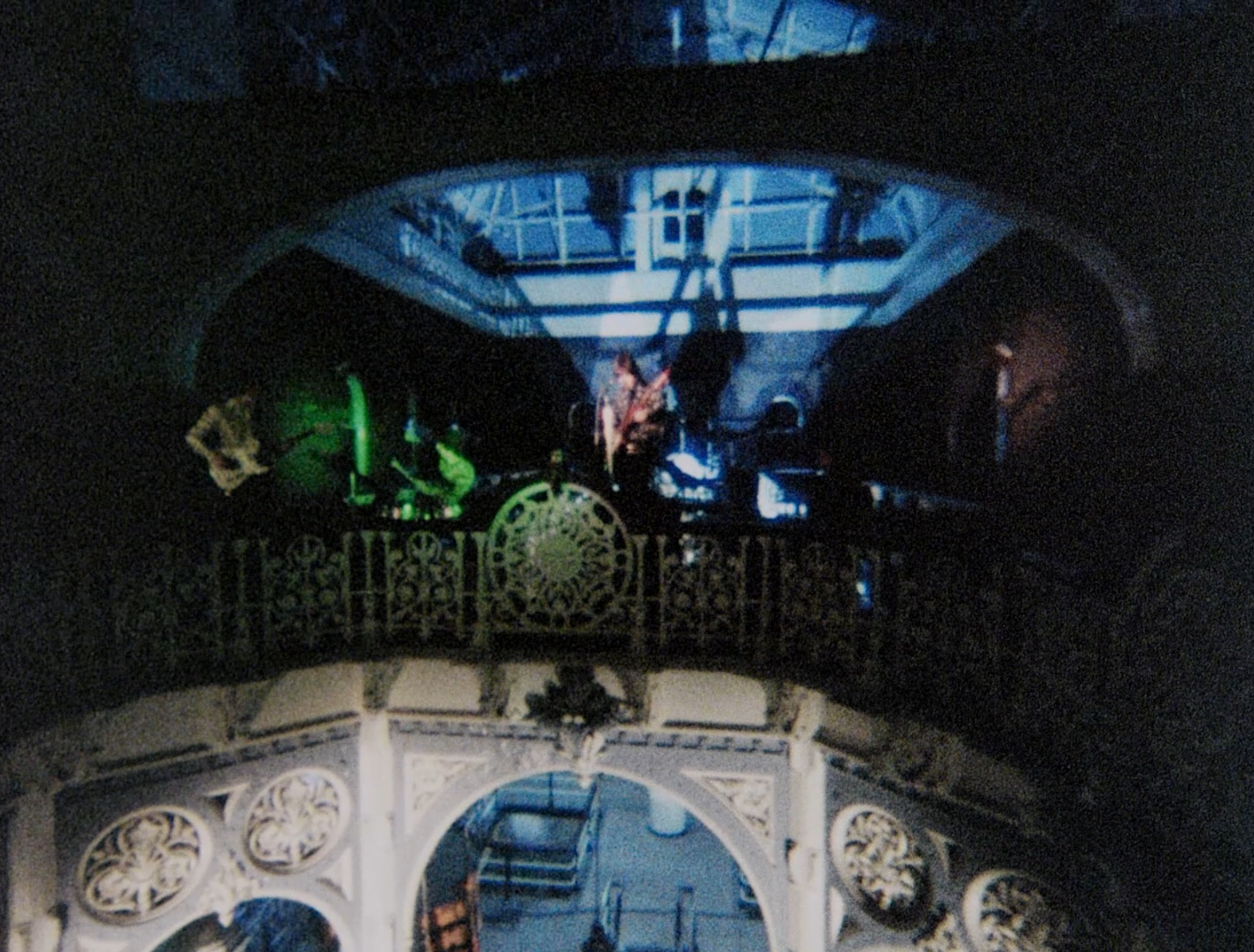
Performance on the BBC TV program ‘Omnibus,’ playing “Set The Controls For The Heart Of The Sun,” highlighting their growing media presence.
Pink Floyd’s 1968 performance on the BBC’s ‘Omnibus,’ playing “Set The Controls For The Heart Of The Sun,” was a pivotal moment in their burgeoning media presence. This appearance on the respected arts program, later included in the documentary ‘All My Loving,’ offered significant exposure, showcasing their evolving psychedelic style and new material from “A Saucerful of Secrets.”
It symbolized the band’s transition in the post-Syd Barrett era, with David Gilmour, and helped broaden their audience, solidifying their influence in the rock music scene.
4 April 1968

Pink Floyd start recording for The Committee Film Soundtrack
Pink Floyd embarked on an intriguing project, providing the soundtrack for “The Committee,” a British avant-garde film directed by Peter Sykes. This collaboration showcased the band’s early foray into film scoring, aligning with their experimental and progressive musical style. The film, known for its abstract and psychological narrative, was a perfect canvas for Pink Floyd’s unique sound, which at the time was deeply rooted in psychedelic and space rock. While the soundtrack they created for “The Committee” didn’t gain the same level of fame as their later works for films like “More” and “Obscured by Clouds,” it remains a fascinating piece of Pink Floyd’s history. This project demonstrated the band’s versatility and their ability to complement and enhance the artistic vision of a film through their music. Unfortunately, the specific pieces Pink Floyd composed for the film were not widely released, making this soundtrack a somewhat hidden gem in their discography.
19 April 1968

Release of their debut single with David Gilmour, “It Would Be So Nice,” marking a new era in the band’s discography.
On 19 April 1968, Pink Floyd released “It Would Be So Nice,” their debut single featuring David Gilmour, marking a significant transition in the band’s discography. This release symbolized a new era for the band, as Gilmour’s involvement heralded a shift in their musical direction following Syd Barrett’s departure. Despite not charting, the single represented an important milestone in Pink Floyd’s evolving sound and artistic journey, reflecting their continuous innovation and exploration in psychedelic rock.
6 May 1968

Pink Floyd play at First European International Pop Festival’ in Rome
Pink Floyd performed at the ‘First European International Pop Festival’ held in Rome, Italy. This event was significant as it was one of the early major international rock music festivals in Europe, signifying the expanding influence of rock and psychedelic music across the continent.
Pink Floyd’s appearance at the festival was part of their early international tours, which played a crucial role in expanding their audience beyond the United Kingdom. Their performance in Rome came during a transformative period for the band, as it was after Syd Barrett’s departure and David Gilmour had joined as his replacement. This change significantly influenced their musical style and stage presence.
The festival itself was a melting pot of various musical acts from different countries, showcasing the diverse styles emerging in rock and pop music at the time. Read about the poster on V&A website.
13 May 1968
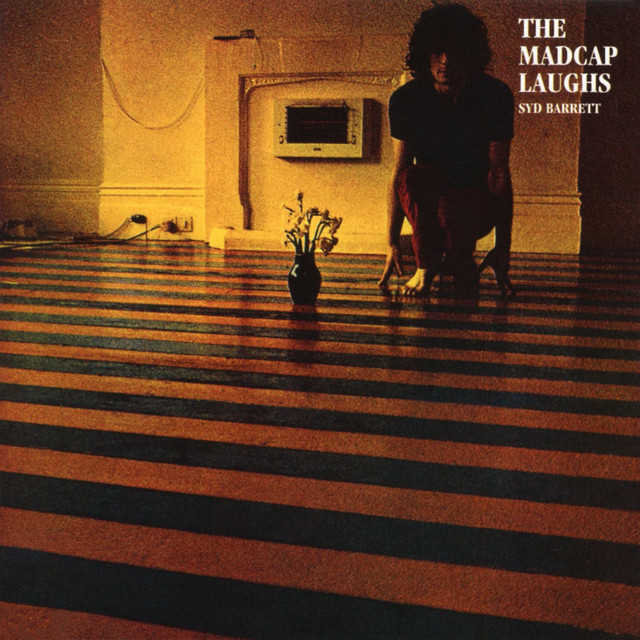
Syd Barrett starts recording The Madcap Laughs solo album at Abbey Road
Syd Barrett began recording his first solo album, “The Madcap Laughs,” in 1968 at Abbey Road Studios, following his departure from Pink Floyd. The recording process, however, was spread out and somewhat erratic, extending into 1969. “The Madcap Laughs” was eventually released in January 1970.
The sessions for “The Madcap Laughs” are notable for their unstructured and spontaneous nature. Barrett, known for his innovative and whimsical songwriting with Pink Floyd, brought a similar approach to his solo work. However, his mental health issues and unpredictable behavior added a layer of complexity to the recording process. Various producers and musicians were involved in the sessions, including former Pink Floyd bandmates Roger Waters and David Gilmour, who helped produce and play on some of the tracks in an attempt to give the album some structure and coherence.
The album itself is a mixture of raw, unpolished tracks and more fully produced songs. It showcases Barrett’s distinctive style, characterized by his whimsical lyrics and unique approach to guitar playing. “The Madcap Laughs” is often seen as a poignant reflection of Barrett’s state of mind during that period, offering a window into his creative genius as well as his struggles.
Despite its fragmented production process, “The Madcap Laughs” has been embraced by fans and critics alike for its artistic authenticity and is considered a significant work in the history of psychedelic and experimental music.
23 May 1968

Pink Floyd at Paradiso Club, Amsterdam
Pink Floyd embarked on a 12-date tour in the Netherlands, which included a notable performance at the Paradiso in Amsterdam. The Paradiso, famous for being a central hub of hippie culture and a key venue for progressive and psychedelic music during the late 1960s, was an ideal setting for Pink Floyd’s innovative and experimental sound.
During this tour, Pink Floyd was transitioning into a new phase of their musical journey. With David Gilmour now a full member, replacing Syd Barrett, the band’s sound and style were evolving. The setlist for these shows included tracks from “A Saucerful of Secrets,” which marked a departure from their earlier, Barrett-led psychedelic style to a more structured, yet still experimental, form of progressive rock.
Songs like “Let There Be More Light” and the title track “A Saucerful of Secrets” were significant inclusions. “Let There Be More Light” opens the “A Saucerful of Secrets” album and showcases the band’s developing style, featuring extended instrumental passages and a more complex musical structure. The title track, an extended, multi-part instrumental, was emblematic of the band’s direction towards more elaborate compositions and would become a staple and highlight of their live performances.
This tour, and particularly the shows at The Paradiso, were crucial in establishing Pink Floyd’s reputation in the burgeoning European rock scene. They were not only promoting their latest album but also testing new musical ideas in front of live audiences, a practice that would become a hallmark of their approach to album creation and live performances.
28 June 1968

Release of “A Saucerful Of Secrets,” reaching No. 9 in the UK charts, signifying their continued success.
On 28 June 1968, Pink Floyd released “A Saucerful of Secrets,” an album that reached No. 9 in the UK charts, underscoring their continued success in the music industry. This release was pivotal as it was the first album to feature David Gilmour and the last with Syd Barrett, marking a significant transition in the band’s line-up and musical style. The album’s chart success demonstrated Pink Floyd’s ability to evolve and maintain popularity amidst changes, solidifying their position as a leading force in the psychedelic rock scene.
The album sleeve is particularly notable because it was designed by Hipgnosis, a new company formed by the band’s friends Storm Thorgerson and Aubrey ‘Po’ Powell. They knew them from Cambridge. They were paid £110 for their efforts.
29 June 1968
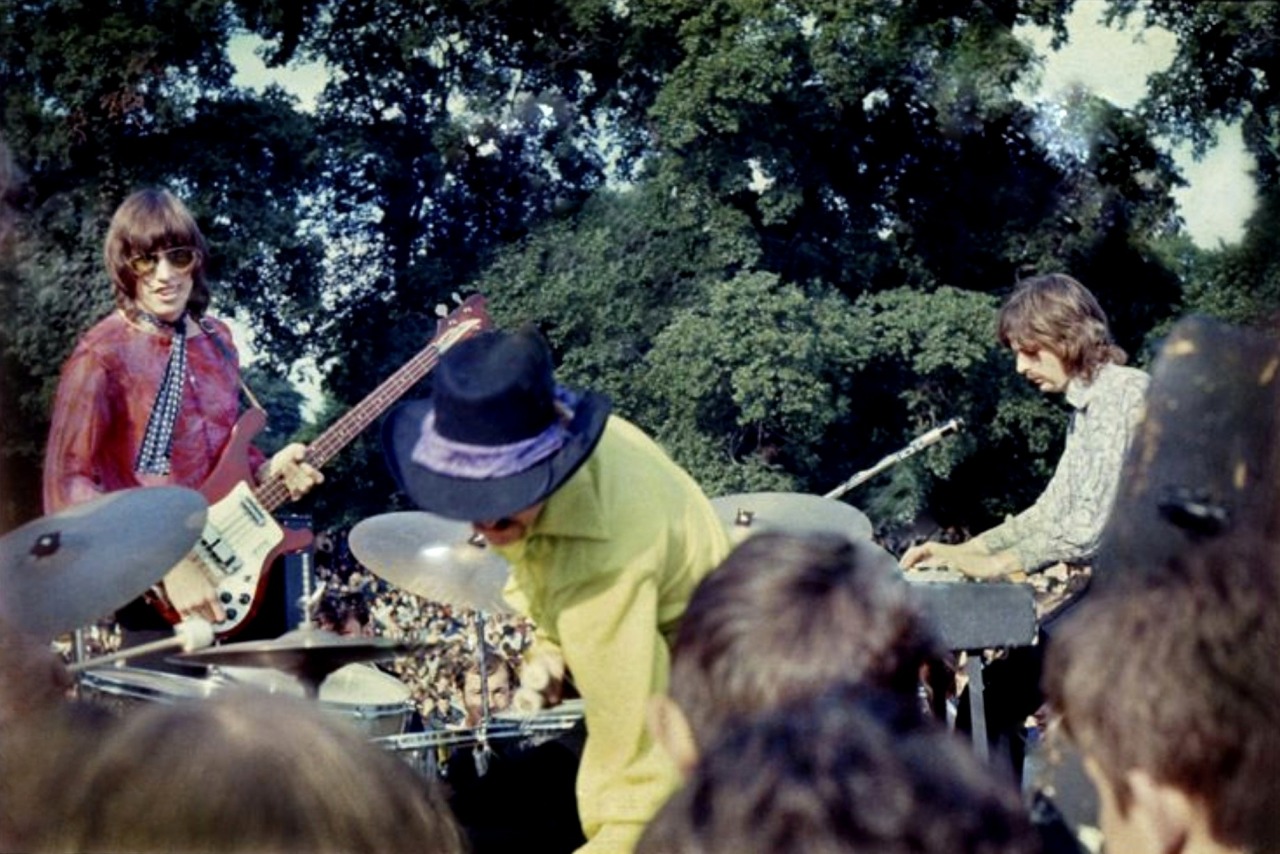
Midsummer High Weekend gig at Hyde Park, London
The ‘Midsummer High Weekend’ concert in London’s Hyde Park, where Pink Floyd headlined over acts like Tyrannosaurus Rex (later known as T. Rex), Jethro Tull, and Roy Harper, was a landmark event. This concert, held on June 29, 1968, was part of a series of free concerts in Hyde Park that became famous during the late 1960s and early 1970s.
For Pink Floyd, their performance at the Midsummer High Weekend was a showcase of their new material from “A Saucerful of Secrets” and a demonstration of their evolving musical direction. The concert was an opportunity for the band to connect with a broader audience and display their innovative live performance style.
Nick Mason, “The one in ’68 was wonderful because it was much more a picnic in the park than a mini-Woodstock. A lovely day. It was important for us too because it reminded us of our, uh, roots — whether spurious or not. They were our roots — not personally, but as an enterprise. We were the house band.”
29 June 1968

Two Gigs in One Day
Having popped back over the pond from their USA Tour in 1968, the band played at Hyde Park in the afternoon at Midsummer High Weekend, and went down to Torquay Middle Earth for the night show. They then returned to America such was the pressure on the band to achieve success. Tough going.
8 July 1968
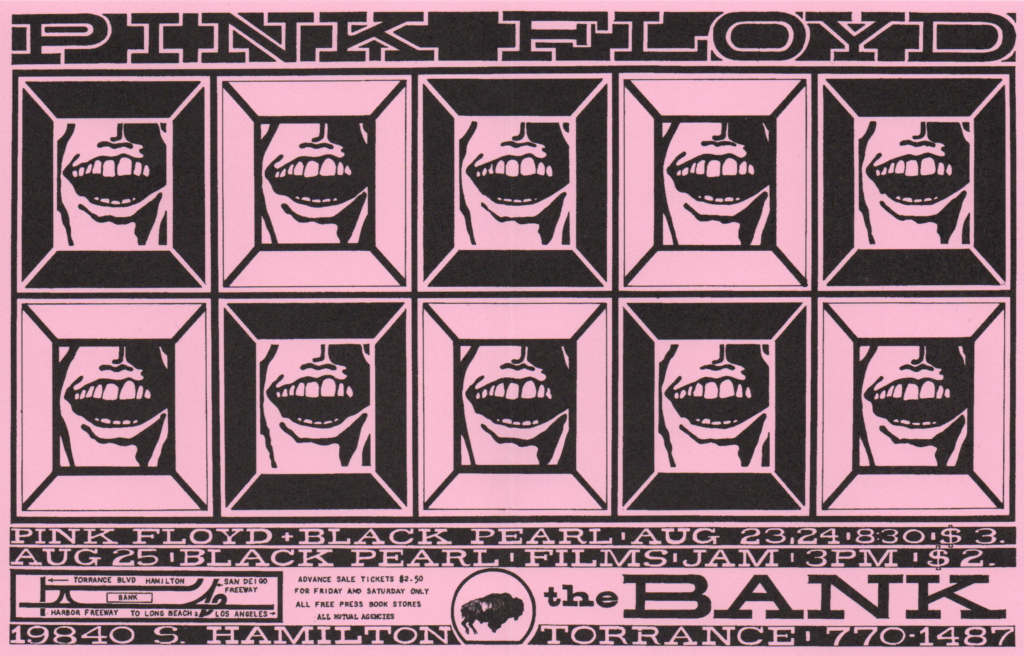
Second USA Tour
On July 8, 1968, Pink Floyd embarked on a significant 22-date tour of the United States, starting at Chicago’s Kinetic Playground. This tour marked an important phase in the band’s expansion into the international music scene, particularly in the United States. The Kinetic Playground, known for hosting various prominent rock acts of the era, was a fitting venue for Pink Floyd to kick off their tour.
The tour concluded on August 24 at The Bank in Los Angeles, another notable venue for rock music at the time. This extensive tour through various cities in the U.S. was a significant step in establishing Pink Floyd’s presence in the American rock music landscape and expanding their fan base outside of the UK.
19 July 1968

Tonite Let’s All Make Love In London
“Tonite Let’s All Make Love in London” is a documentary film released in 1967, directed by Peter Whitehead. This film is a vivid portrayal of the swinging London scene during the 1960s, capturing the cultural and social revolution that was taking place in the city at that time. The title of the film is a reflection of the free-spirited, progressive, and somewhat hedonistic atmosphere that characterized London during this era.
Pink Floyd’s involvement in the documentary is particularly noteworthy. They contributed to the soundtrack, which included their early psychedelic sound that was emblematic of the period. The film features live performances and interviews with key figures from the music, art, and literary scenes of 1960s London, with Pink Floyd being a significant representative of the music scene.
The soundtrack, including Pink Floyd’s contributions, is an essential element of the film, encapsulating the mood and spirit of the time. Their music added an atmospheric and immersive quality to the documentary, aligning well with its exploration of the youth culture and the burgeoning counterculture movement in London.
“Tonite Let’s All Make Love in London” serves as a historical document of a pivotal moment in cultural history, and Pink Floyd’s participation in the project highlights their role as one of the leading voices in the psychedelic music movement of the 1960s.
See photos from Tonite Let’s All Make Love In London
26 September 1968

The Committee Film Premiere in London
The Committee underground cult classic film had its premiere at Watford Empire on 26th September 1968. Directed by Peter Sykes, the film is notable for featuring original music by Pink Floyd.
4 October 1968

UK/France Tour
Pink Floyd performed 10 dates in the UK and France, commencing at Mothers in Birmingham and ending at London’s Middle Earth on 26 October.
16 November 1968

Pink Floyd’s First time in Switzerland
Pink Floyd played their debut gig in Switzerland at Restaurant Olten-Hammer in Olten. The band played a further two shows in the country. The photo is in Zurich.
1968-11-16 : Restaurant Olten-Hammer, Olten, Switzerland
1968-11-16 : Grosse Tanzparty, Abtwil, Switzerland
1968-11-17 : Kongresshaus, Zurich, Switzerland
23 November 1968

Back to School! Pink Floyd perform at Regent Street Polytechnic
Pink Floyd played London’s Regent Street Polytechnic, the alma mata of Roger Waters, Richard Wright and Nick Mason.
6 December 1968

Point Me At The Sky single released
6 December 1968
Pink Floyd released a new single called Point Me At The Sky along with its B-side Careful With That Axe, Eugene. It failed completely to chart in the UK even though it was accompanied by a promo film of the band flying in a Tiger Moth aeroplane at Biggin Hill Aerodrome. See Video.
This failure to chart will have been a disappointment for the band. They would generally become an album oriented band insted of a singles focusd band after this point. A milestone in the history of the band. The album matters more than the vital single!
28 December 1968
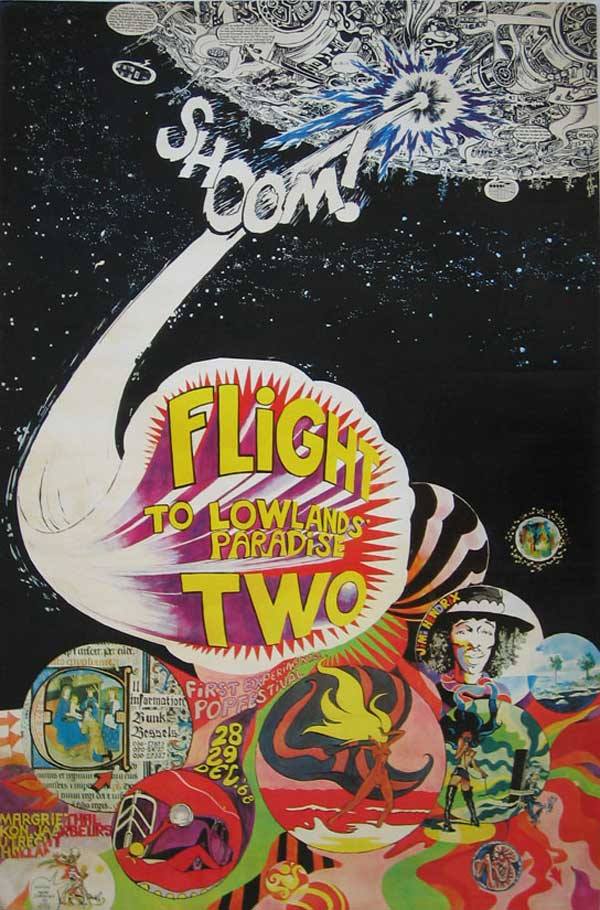
‘Flight To Lowlands Paradise II’ festival
28 December 1968
The “Flight To Lowlands Paradise II” festival, a predecessor to the modern-day Lowlands festival, took place on 28 December 1968. Pink Floyd replaced advertised headliners The Jimi Hendrix Experience in Utrecht, Netherlands. The festival, held in Utrecht, was sold out with a capacity of 18,000 visitors. However, this popularity led to a situation where many attendees could not get inside, resulting in unrest and requiring police intervention.
This was the final concert in 1968 for Pink Floyd
